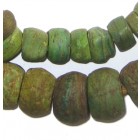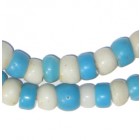
‘Russian Blues’ were a popular type of Trade Bead produced in old Bohemia (now the Czech Republic) during the 19th Century. Their popularity among African and Amerindian tribes stems from the fact that, unlike most Trade Beads which were typically oval or tubular, these particular Trade Beads were faceted like precious gems. Most beads comprised eighteen or twenty-four facets, however larger, elongated beads generally had twelve. These particular Bohemian beads were commonly produced in a limited spectrum of dark to mid blue, and ranged in size from 5-12mm. Early 20th Century beads were produced in green and lighter blue shades.
The moniker “Russian Blues” derives from the fact these old Czech beads were brought in vast quantities to the US and Canada by Russian fur traders in the 19th Century. Following the discovery of Alaska by Vitrus Bering in 1741, Russian merchants began exporting large quantities of glass beads, copper kettles and tools in exchange for sea otter pelts. Captain James Cook set sail for America in 1778 in an attempt to find out more about the endeavors of the Russians, and it is allegedly his reports which prompted both English and European merchants to follow in their footsteps. By the mid 19th Century, European merchants had established numerous trade networks in African and America, and Russian Blues played a central role in the exploitation of the regions for commercial gain.
Early Russian Blues were created by a process known as “drawing” – similar to that used for Venetian Chevron Beads. First, a bubble would be formed at the center of a glass tube by pulling it whilst hot. This would form the perforation hole. A second puntile (a long, hollow metal tube) would then be attached to the tube at the opposite end, and the glass pulled until the desired width was achieved. The molten glass would be cut whilst still hot, and after cooling, the sides ground by hand to achieve facets at specific angles. Later Russian Blues were cast in molds, however, were almost always hand finished in the same manner.
References:
Faceted Bohemian Beads, Exhibit 11. Picard Beads
Russian Blue Trade Beads, History. Active Artist Network
King Beads are a type wound Venetian trade bead produced throughout the 19th and 20th Century in Murano, Venice, primarily for trade with Africa and America. They are distinguishable from striped Chevron Beads by their bicone shape, and the fact they do not feature a rosetta around the perforation hole. African legend tells that King Beads got their name because of their popularity among tribal chiefs up until the 1970s.
The earliest known examples of King Beads feature on numerous sample cards donated by Moses Lewin Levin to the British Museum around 1865. Early 20th Century King Beads (dated 1920) also feature within a collection of sample cards donated by Sick and Co; a German company who, until 1964, were one of Europe’s largest exporters of Trade Beads to Africa.
King Beads are one of the earliest types of biconical Trade Bead to have been produced by the marvering method. A marver is a long, thin rod made of copper, around which heated glass is slowly wound. A paddle or steel flipper is used to shape the glass whilst hot, and trails of colored glass then applied to create the distinctive polychromatic stripes. Nineteenth century King Beads were commonly produced in black, green and yellow varieties, with trailed horizontal stripes in two to three colors.
References:
King Beads, About African Beads
French Cross Beads (also known as “Bodoum Beads” in parts of West Africa) were a popular type of wound Venetian Trade Bead produced in limited quantities throughout the 19th Century. Their intended purpose was use as a medium of exchange or currency in new territories, such as Africa and South America, although they also found their way to parts of Asia in the early 20th Century.

Yellow and White French Cross Beads
So called because of the distinctive polychrome cross designs on their outer skins, French Cross Beads realized considerable value among tribes along the Ivory Coast and central Mali. They were produced in both yellow and white – the latter being far more scarce than the colored varieties. While most beads featured a single cross design in one or two colors on either side of the bead, others were decorated with trailed and cross-hatched designs. French Cross Beads were produced in a variety of sizes ranging from a tiny 5mm to just over 12mm.
The production of Bodoum Beads involved an ancient bead-making technique known as winding or marvering. Glass is first heated in a furnace to make it ductile, then whilst still hot, is slowly wound around a copper mandrel coated in clay or borum nitride. This would form the bead release, which made it easier to ‘release’ the beads later on. While the glass was still hot, it would be manipulated with a flat-sided paddle to achieve the spherical shape. Finally, thinner strips of hot glass would be applied to create the cross design.
Much like old Venetian King Beads, French Crosses were only produced in limited number, and were therefore considered particularly valuable by tribes in Africa owing to their scarcity. They were commonly exchanged for valuable elements, such as gold and silver, as well as heavy animal pelts and palm oil. Today, French Cross Beads are still considered quite valuable, and can fetch between $50 and $300 at online auction.
References:
Wound Glass Beads – Wikipedia
French Cross Beads - About African Beads

Green Hebron Beads
Hebron Beads (sometimes referred to as Kano Beads) are a form of glass Trade Bead which originate from the Holy city of Hebron in Palestine. The city is rather better known as the final resting place of the patriarchs and matriarchs of the Jewish, Muslim and Christian faiths, however, also has a long and fascinating history of glass-making which dates back to 63 BCE. These early glass beads were blown spheres of round glass, simply decorated with evil eye designs to ward off malevolent spirits. Hebron Beads are typically donut-shaped with a far courser finish.
The earliest known beads produced in Hebron for trade were manufactured during the 18th Century. British explorer William George Brown references two different sizes of bead – Hershe and Munjir – produced in the region in his journal of 1799, with further observations detailing their course texture and rustic finish. Their eroded aesthetic derives from the fact that they are made with salts from the Dead Sea, and sand from the outlying village of Bani Na’im.
As trade networks developed between Africa, Palestine and Egypt in the early 1800s, Hebron’s glass-makers began producing beads exclusively for trade in foreign lands. They were particularly well received by the Igbo and Yoruba tribes of Kano, Nigeria, both of whom consider large, heavy beads to be indicative of wealth and social status. The Yoruba, however, noticed that the rough glass beads did not sit uniformly when strung upon a raffia, and so ground down the sides of the beads themselves using flattened stones. Early historians were originally of the impression the beads were produced by the Yoruba – hence the name “Kano Beads”.

Antique Blue and White Padre Beads
Padre Beads (also known as “Peking Glass”) are a type of wound glass Trade Bead used as a medium of exchange for furs in Africa and America between the 1650s and 1920s. Their official country of origin is China, where they were produced exclusively for the costumes of Chinese courtiers during the Ching Dynasty. Latterly, they were manufactured throughout Europe – notably in France and Venice. The humble Padre Bead was first used in trade around the early 18th Century, exported via China to Europe for use by explorers developing trade links with American Indians.
Padre Beads are so named because of their use as prayer beads among Spanish friars and monks. These later beads were of European origin, and were first introduced to Africa by Franciscan monks carrying out missionary work along the Gold Coast. In North America, traders found that the Nez Perce Indians particularly coveted the turquoise blue wound beads over others because it reminded them of the sky (heaven). This was further documented by English explorer Captain James Cook in 1778, whom wrote of his difficulty in obtaining supplies from the Indians without this specific “chief bead”.
Despite the popularity of turquoise and white beads among the Nez Perce, they were actually produced in a wide spectrum of colors. European Padre Beads were also manufactured in three distinct sizes: Dogons, which could be up to ¾ of an inch in diameter; Crows, which measured approximately 3/8 of an inch, and Pony Beads, which were a mere 3/16 of an inch in size. Padre Beads are typically wider than Dutch Dogons, yet smaller than wound Hebron Beads.
Dogon Beads (also referred to as “Dutch Dogons”) are a type of Trade Bead found in abundance in the town of Bandiagara, Mali. They are so named because of their popularity among the Dogon people of Mali; an ethnic group which makes up over 70% of the Mopti region’s populace.

Blue Dogon Beads
Dogons found their way to Mali in the 19th Century aboard merchant ships. Prior to this, they were manufactured in Amsterdamexclusively for decorative use in mosaic gardens in the Zaanstreek District of the city. Spurred by an increased demand for Trade Beads by tribes in Africa, glass-makers began producing the small donut beads in far greater quantities for use as a medium of exchange. Historical records show that the vast majority of Dogon Beads manufactured for export ended up in either Mali, or along the Gold Coast; exchanged with local tribal leaders for favors, slaves, furs and exotic spices.
Unlike many Trade Beads, Dutch Dogons were named after the tribespeople of the Mali region. It is believed this may be due to the fact that Dogon people took it upon themselves to further manipulate the beads by wearing down the sides, so that they would sit more uniformly upon a length of sisal. Early Dogon Beads were quite crudely made. They often featuring a raised area around the perforation hole – the result of a laborious winding process. Most Dogon Beads sold today have been re-shaped by Mali dealers, allowing them to be easily strung upon necklaces and bracelets as spacers.
References:
Padre Beads, Dixon’s Trade Bead Encyclopaedia.
About Padre Beads, AboutAfricanBeads.com